The Broad-tailed Hummingbird (Selasphorus platycercus) stands as a jewel among North American avifauna, captivating enthusiasts with its vibrant plumage and remarkable behaviors.
Thriving in high-altitude environments, this species navigates the mountainous landscapes of western North America, from the Rockies to Mexico.
Distinguished by the iridescent green feathers of males and a dazzling rose-red throat, these hummingbirds engage in aerial displays marked by melodious wing trills.
As agile foragers, they sustain themselves primarily on floral nectar and occasional small insects.
Nesting in meticulously crafted cup-shaped nests, their breeding rituals involve courtship displays showcasing their forked tail feathers.
With a migratory journey spanning vast distances, the Broad-tailed Hummingbird symbolizes resilience in the face of environmental challenges, emphasizing its unique ecological role and enchanting presence in the wild. Stay sharp.
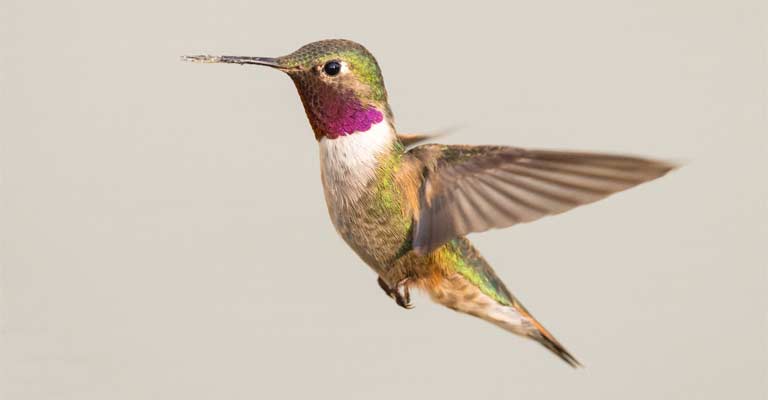
Identifying Characteristics of Broad-tailed Hummingbird
The Broad-tailed Hummingbird (Selasphorus platycercus) is a captivating and vibrant species that can be found in the western regions of North America.
Identifying this particular hummingbird involves observing a combination of physical characteristics and behaviors that set it apart from other hummingbird species.
Here are some key points to help in the identification of the Broad-tailed Hummingbird:
Distinctive Plumage
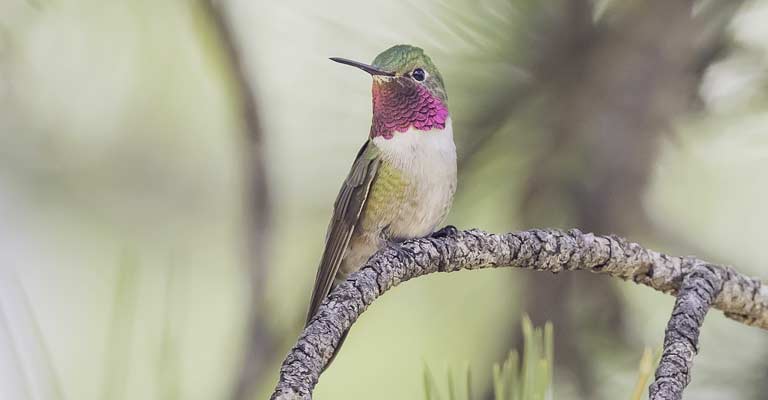
One of the most prominent features of the Broad-tailed Hummingbird is its striking plumage.
Males typically have iridescent green feathers covering their bodies, while the throat exhibits a dazzling rose-red color that catches the sunlight.
Females, on the other hand, are slightly more muted with greenish-gray feathers and a less vibrant throat.
Vibrant Gorget
The male’s gorget, or throat patch, is a defining characteristic. The brilliant rose-red coloration extends from the chin to the upper chest.
This vibrant gorget plays a crucial role in attracting mates and establishing dominance during territorial disputes.
Audible Wing Trill
As the Broad-tailed Hummingbird hovers or flies rapidly, its wings produce a distinct high-pitched trill.
This audible sound is created by the rapid beats of its wings and is particularly noticeable during courtship displays and aggressive encounters with other hummingbirds.
Forked Tail Feathers
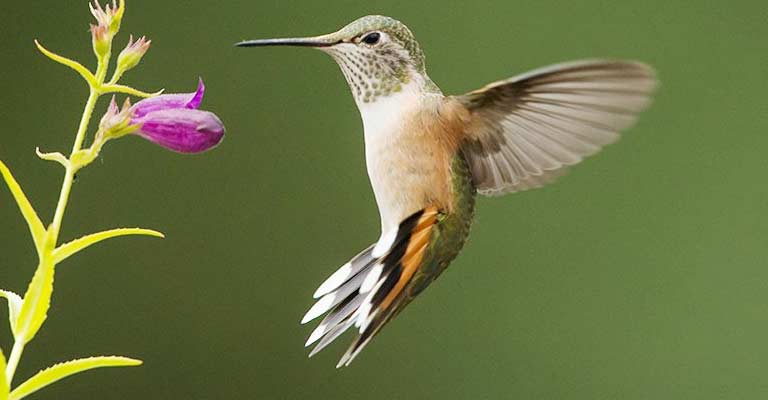
Another key identification feature is the presence of forked tail feathers.
These feathers contribute to the bird’s agility in flight and aid in distinguishing it from other hummingbird species. The tail feathers are often broader than those of similar hummingbirds.
Geographic Range
Knowing the bird’s geographic range is crucial for identification.
Broad-tailed Hummingbirds are primarily found in mountainous and high-altitude regions, ranging from the western United States, including the Rocky Mountains, to parts of Mexico.
Understanding their habitat preferences helps narrow down potential species.
Migration Patterns
Broad-tailed Hummingbirds are known for their impressive migratory journeys.
They travel considerable distances, often crossing mountain ranges, during seasonal migrations. Observing their migration patterns can aid in confirming the bird’s identity.
Size and Shape
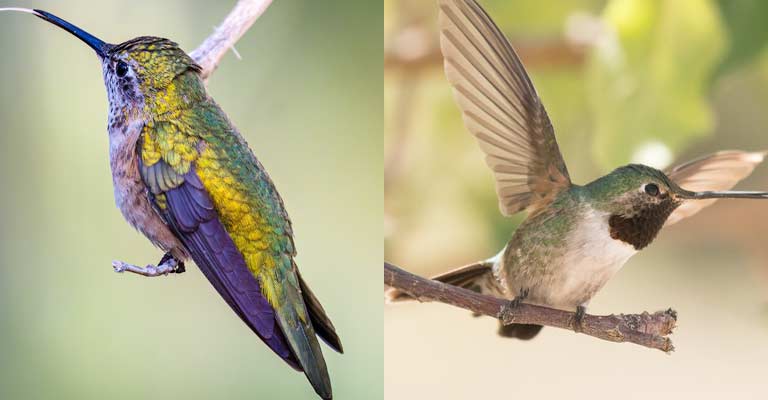
The Broad-tailed Hummingbird is a relatively small bird, with males and females being similar in size. They have a compact body and short bill, contributing to their agile and acrobatic flight.
Paying attention to these size and shape characteristics can assist in distinguishing them from other hummingbirds.
Feeding Behavior
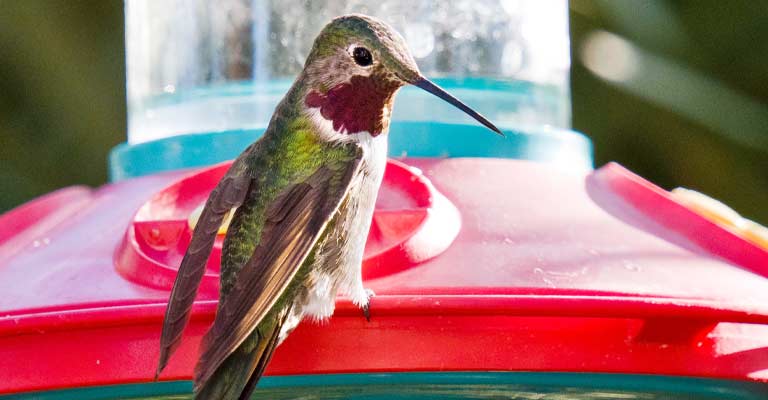
Understanding the bird’s feeding behavior is crucial for identification. Broad-tailed Hummingbirds, like other hummingbirds, are nectar feeders.
They use their specialized bills and long tongues to extract nectar from flowers. Observing their feeding habits, such as hovering near flowers and rapid darting movements, helps in confirming their identity.
Identifying the Broad-tailed Hummingbird involves a combination of visual and behavioral cues.
By paying attention to the distinctive plumage, vibrant gorget, audible wing trill, forked tail feathers, geographic range, migration patterns, size and shape, and feeding behavior, bird enthusiasts can confidently recognize and appreciate this captivating species in their natural habitat.
Taxonomy of Broad-tailed Hummingbird
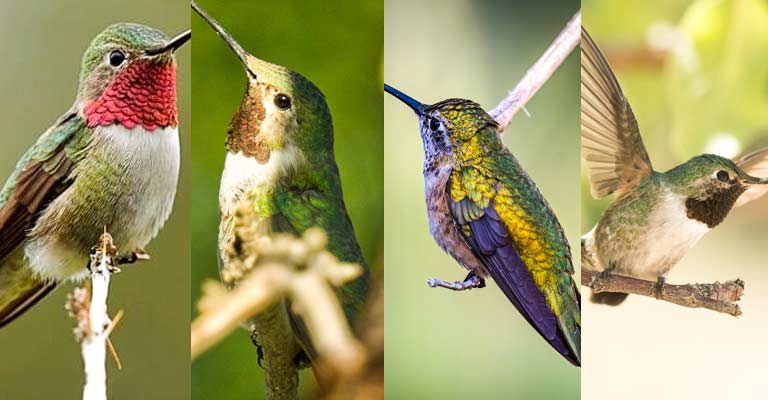
Here’s a table summarizing the taxonomy details of the Broad-tailed Hummingbird:
| Taxonomic Level | Classification |
| Domain | Eukaryota |
| Kingdom | Animalia |
| Phylum | Chordata |
| Class | Aves |
| Clade | Strisores |
| Order | Apodiformes |
| Family | Trochilidae |
| Genus | Selasphorus |
| Species | S. platycercus |
This table outlines the hierarchical classification of the Broad-tailed Hummingbird, highlighting its place in the broader taxonomic structure.
From the Eukaryota domain to the species level, each classification provides insight into the bird’s evolutionary relationships within the animal kingdom.
The Broad-tailed Hummingbird (Selasphorus platycercus) belongs to the Animalia kingdom, Chordata phylum, Aves class, and Strisores clade.
It is classified under the Apodiformes order, Trochilidae family, and Selasphorus genus.
Identified by its vibrant plumage and distinctive forked tail, this species showcases its avian lineage within the broader context of the animal kingdom.
As an agile and high-altitude inhabitant, its taxonomic classification highlights its evolutionary position among birds, particularly in the order of swift and hummingbird species within the Trochilidae family.
Broad-tailed Hummingbird Life History
The life history of the Broad-tailed Hummingbird (Selasphorus platycercus) unfolds with captivating intricacies, from its feeding habits and preferred habitats to its breeding behaviors and the challenges it faces in the realm of conservation.
Delving into the various facets of this hummingbird’s life provides a comprehensive understanding of its role in the ecosystems it inhabits.
Food
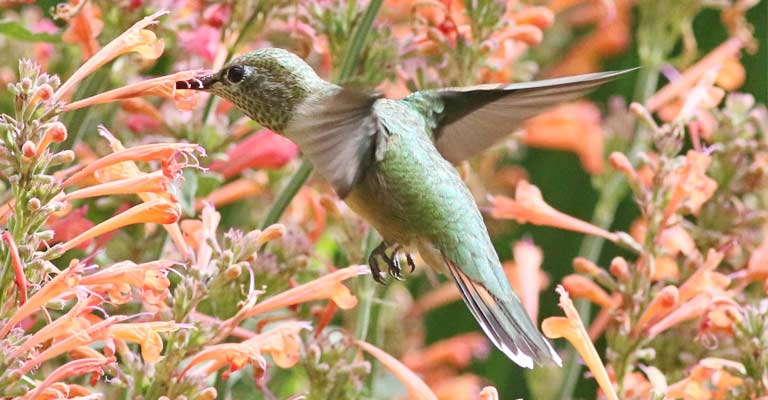
Broad-tailed Hummingbirds primarily sustain themselves on a diet of nectar extracted from a variety of flowering plants.
Their specialized bills and extendable, tube-like tongues enable them to access the sweet liquid within flowers.
In addition to nectar, they also consume small insects and spiders, providing essential proteins and nutrients, especially during the breeding season.
Habitat
These hummingbirds exhibit a preference for montane and high-altitude environments. They are commonly found in coniferous and mixed-coniferous forests, as well as meadows and shrubby areas.
The availability of suitable flowering plants for nectar, along with appropriate nesting sites, influences their habitat selection.
Range Map
The Broad-tailed Hummingbird’s range extends across western North America, encompassing parts of the United States, such as the Rocky Mountains and surrounding regions, and stretching down into Mexico.
Their migratory nature sees them cover extensive distances, emphasizing the importance of maintaining interconnected habitats throughout their range.
Nesting
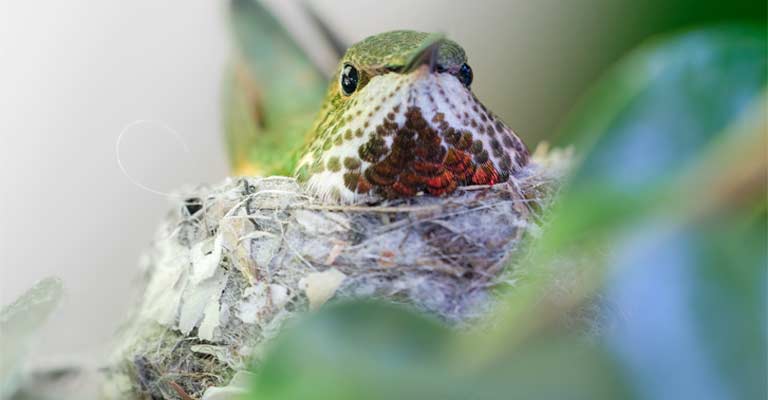
Nesting is a meticulous process for these hummingbirds. Females construct compact cup-shaped nests using plant materials, lichens, and spider silk, often attaching them to branches for stability.
The nests are strategically placed to provide safety from predators and adverse weather conditions.
Understanding their nesting behaviors contributes to conservation efforts by identifying and protecting crucial breeding sites.
Here’s a table summarizing the nesting details of the Broad-tailed Hummingbird:
| Nesting Details | Facts |
| Clutch Size | Typically 2 eggs per clutch |
| Number of Broods | Usually 1 to 2 broods per season |
| Egg Length | Approximately 1.3 cm (0.5 inches) |
| Egg Width | Around 0.8 cm (0.3 inches) |
| Incubation Period | Approximately 16 to 18 days |
| Nestling Period | About 20 to 23 days |
| Egg Description | Small, white, pea-sized eggs with a smooth surface |
| Nest Construction | Cup-shaped nest made of plant materials, lichens, and spider silk |
| Nest Placement | Often attached to branches for stability and concealed from predators |
| Incubation and Parental Care | Both male and female share incubation duties, and both parents care for the nestlings |
| Fledgling Independence | Young hummingbirds become independent after leaving the nest, but parental care may continue for a short period |
This table provides a concise overview of key nesting characteristics of the Broad-tailed Hummingbird, offering insights into their reproductive behaviors and strategies for raising offspring.
Breeding
Breeding among Broad-tailed Hummingbirds typically occurs in the spring and summer months.
Males engage in elaborate courtship displays, showcasing their vibrant throat colors and performing aerial acrobatics to attract potential mates.
After successful courtship, females lay two white, pea-sized eggs, and both parents take turns incubating the eggs and caring for the fledglings upon hatching.
Diseases
Like many bird species, Broad-tailed Hummingbirds are susceptible to diseases, with avian parasites posing a potential threat. Common issues include mites and pathogens that can affect their health and reproductive success.
Monitoring and understanding disease dynamics are crucial for implementing effective conservation measures.
Treatment
Efforts to mitigate disease risks involve maintaining healthy habitats, minimizing stressors, and implementing supplementary feeding programs with clean nectar solutions.
Conservationists and researchers work towards identifying and addressing specific diseases affecting Broad-tailed Hummingbirds to ensure their well-being.
Conservation
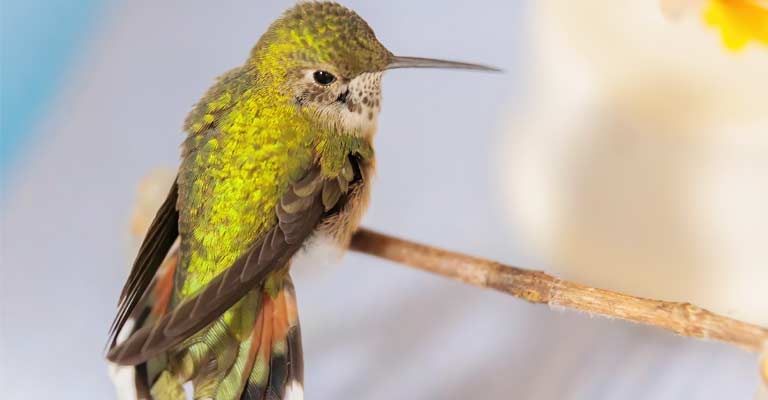
Conservation initiatives play a pivotal role in safeguarding the Broad-tailed Hummingbird and its habitats.
Protecting nesting sites, preserving diverse floral resources, and establishing corridors for migration are vital components of conservation strategies.
Public awareness campaigns further contribute to fostering a sense of responsibility toward the preservation of this mesmerizing species.
The life history of the Broad-tailed Hummingbird is a testament to the delicate balance it maintains within its ecological niche.
From foraging on nectar and insects to navigating extensive migration routes, this hummingbird’s journey is a testament to the intricate web of relationships within its environment.
Conservation efforts aimed at understanding and addressing the various aspects of their life history are essential for ensuring the continued presence of these enchanting birds in the wild.
10 Fun Facts About Broad-tailed Hummingbirds
The Broad-tailed Hummingbird (Selasphorus platycercus) is a fascinating and charismatic species with a range of captivating features. Here are 10 fun facts about these delightful hummingbirds:
- High-Altitude Flyers: Broad-tailed Hummingbirds are well-adapted to mountainous regions, often inhabiting areas at elevations exceeding 9,000 feet. Their ability to thrive in such high-altitude environments sets them apart from many other hummingbird species.
- Migratory Marvels: These hummingbirds embark on impressive migratory journeys, covering vast distances between their breeding grounds in North America and their wintering grounds in Mexico. Their migration showcases their endurance and navigational prowess.
- Musical Wings: During their rapid and agile flight, Broad-tailed Hummingbirds produce a distinctive high-pitched trill. The sound is created by the rapid beats of their wings and adds a musical element to their aerial displays.
- Dazzling Gorget Displays: Male Broad-tailed Hummingbirds boast vibrant, rose-red gorgets, which they use to attract mates and establish dominance. The dazzling throat colors play a crucial role in courtship rituals and territorial interactions.
- Floral Nectar Connoisseurs: Their primary diet consists of floral nectar, which they obtain using their specialized bills and long, extendable tongues. This nectar serves as their energy source, and they are known to feed on a variety of flowering plants.
- Forked Tail Finery: The Broad-tailed Hummingbird features distinctive forked tail feathers. These feathers not only contribute to their agile flight but also add to their overall charm and uniqueness among hummingbird species.
- Courtship Acrobatics: During the breeding season, males engage in mesmerizing courtship displays. These displays involve intricate aerial acrobatics, including steep dives and sudden ascents, showcasing their agility and strength.
- Tiny Nests of Precision: Female Broad-tailed Hummingbirds meticulously construct tiny cup-shaped nests using plant materials, lichens, and spider silk. The nests are often attached to branches, providing a secure and camouflaged haven for their eggs.
- Rainbow of Migration: The Broad-tailed Hummingbird’s migration route takes them through diverse landscapes, from the alpine regions of the Rockies to the warmer climates of Mexico. Their migratory journey adds a vibrant touch to the ecosystems they traverse.
- Conservation Concerns: Despite their resilient nature, Broad-tailed Hummingbirds face threats such as habitat loss and climate change. Conservation efforts are crucial to preserving their habitats and ensuring the continued existence of these enchanting birds.
The Broad-tailed Hummingbird is a remarkable species, blending physical prowess with vibrant displays and showcasing the marvels of avian migration.
Wrapping Up
In the intricate tapestry of nature, the Broad-tailed Hummingbird emerges as a high-altitude marvel, enchanting with vibrant plumage, melodious flights, and resilient migratory feats.
From their musical wing trills to the precision of their tiny nests, these hummingbirds captivate not only with their physical prowess but also with their crucial role in ecosystems.
As they traverse mountainous landscapes and engage in mesmerizing courtship displays, the Broad-tailed Hummingbird becomes a symbol of resilience amid environmental challenges.
Conservation efforts are imperative to preserve their habitats and ensure the continued grace of these aerial wonders. Best of luck.